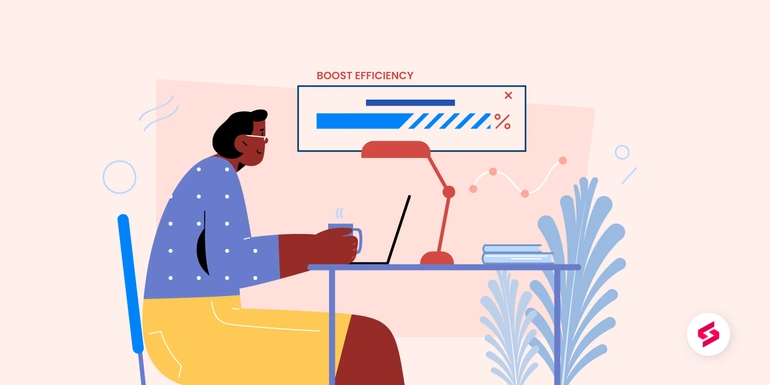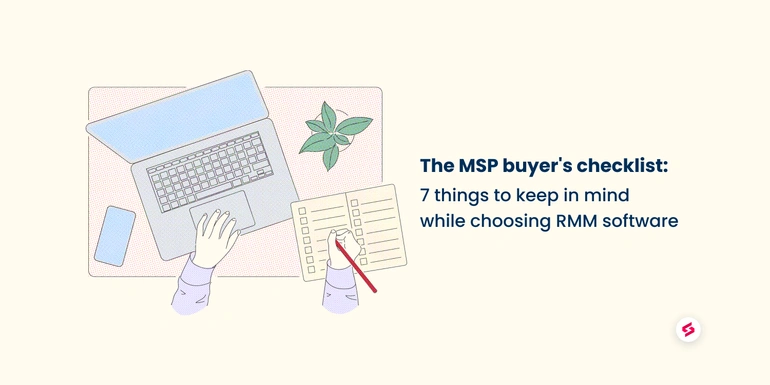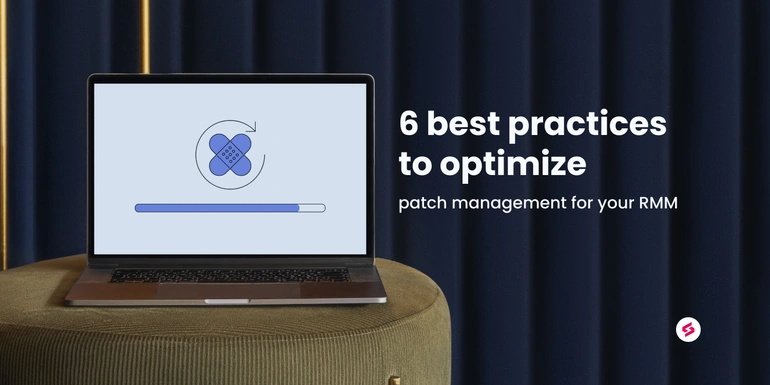11 best RMM platforms for 2023
If you’re an MSP looking for an RMM, how do you go about it? We’ve just made it easier for you - we chose top 10 platforms in the market and compared them extensively against each other to bring you the best of the best. Without further ado, let’s dive in.
SIGN UP FOR SUPEROPSIt’s rare to be an MSP and not spread across a large geographical area. And if a large, diverse clientele is your superpower, then heavy will be the burden of your responsibility.

These companies entrust in you, the MSP, the safety and well-being of their IT environments.
The enormity of the task is obvious. We are talking about thousands of client devices spread across locations and you have to make sure that everything is up and running. And not just that, you have to predict and prevent major issues from happening and hampering productivity, lest your client lose their trust in your capabilities.
Now, it's not even possible to have engineers be physically available at client endpoints monitoring their health, and the network’s all the time. This is where Remote Monitoring and Management (RMM) tools enter the scene, knowing all too well that they may have had your curiosity but now they have your undivided attention.

Simply put, RMM tools help MSPs monitor and manage client endpoints, computers, and networks remotely. These are deployed by installing “agents”, very small programs, on the client’s devices, which include laptops, mobile devices, desktops, servers, etc. These agents send data back to the MSP about the status and functioning of the client’s systems and the health of their network. If they find any deviation from normal behavior at any node or endpoint, they send an alert to MSP and raise tickets that can be resolved as per criticality. You can monitor machine usage, manage and update them and even predict any upcoming issues, prevent it or deploy a solution at the earliest - all from one console.
Now if you’re an MSP looking for an RMM, how does one go about it? More often than not, prior experience with a tool—good or bad—can impact your choice. But with changing trends and advancing technology and innovation, that’s no longer the best idea.
Now at SuperOps, we want to stay ahead of the curve and in the mix of (preferably on top of the pile of) everyone’s favorite RMMs. We want you to pick us because we are better at something that you need; not just by claiming it, but by being it. This means we had to research a lot of competitors and industries in general. If they are doing something right for our customers, we want to do it better! There’s just too much to see, learn, and do.
The learnings we got from such research can be useful to you too; in your search for the right tool for you as an MSP and your client's IT environment. So here’s one of our favorite bits of research, where we compared our product to competitors and ranked them according to client needs. We have this list handy because our aim is to be at the top of it - the sooner the better.
Now for this research, we browsed through a lot of G2 and other reviews, listened to influencers, and did some of our own diggings. For starters we chose these ten platforms - Atera, Ninja One, Syncro, Datto, Kaseya, Connectwise, Naverisk, ManageEngine Central Central, Comodo, and N-able and compared them with our own SuperOps platform
We didn’t include Microsoft Intune because it was focused only on mobile devices and some older RMMs due to their difficult to learn/navigate interfaces.
Here’s a quick introduction to all of them:
SuperOps: Launched in 2020, our combined PSA-RMM platform is for those MSPs who want a modern, unified platform powered by AI. Features like remote asset health management, intelligent alerting, intelligent ticket routing, and integrated service desk help in the delivery of world-class IT support services to businesses of all sizes.
NinjaRMM: NinjaOne’s RMM offering has been around for quite some time and has a good reputation in the industry. With the addition of ticketing, data protection, and IT documentation services, it is now more of a robust suite than just an RMM system. Their pricing isn’t quite transparent; you have to get an independent quote to find out how much it’ll cost you, but there is a free trial.
Atera: This one leads has good remote access capabilities and ease of use. It has a simple UI that’s easy to learn and has a great mobile app too. The pricing also is transparent and starts at $79/agent per month.
ManageEngine Desktop Central: Zoho’s ManageEngine Central is a suite of endpoint management tools that works well as an RMM system for a managed service provider or internal IT department. Mobile device management is however an add-on. It has a free version that supports monitoring of up to 25 computers and mobile devices making it an SMBs favorite. Pricing is customized and quotes can be requested.
Naverisk: Naverisk is another PSA-RMM platform that aims to solve multiple issues for MSPs. Delivers most of the existing competitor’s features. Pricing starts at $110 per month and custom quotes are given to clients on request.
Syncro: An MSP platform that combines RMM capabilities with payments, marketing, and more, It offers a free 30-day trial and the plans start at $119/user per month.
ITarian: ITarian is one of the most well-known RMM products in the market. They offer most of the services and you can buy add-ons for additional features. It offers a free version of up to 50 endpoints, which is ideal for smaller enterprises, and each endpoint after that is charged at $1.25 per month.
N-able RMM: N-able is a great RMM tool with an easy-to-use UI.This tool offers a free trial and has a personalized pricing model that can be requested directly from your company.
ConnectWise Automate: Formerly known as LabTech, this RMM tool is fully integrated with ConnectWise’s platform and is known more for its capabilities of automated IT backups than just remote management.
Kaseya VSA: Kaseya is a good option that has been around for quite some time and offers a robust bunch of features.
Datto: Another cloud-based tool aimed at MSPs, Datto has been recently upgraded with a new UI and has some integration options for PSAs and other tools used by MSPs.
We must let you know that Kaseya had a major security breach in 2020 where many of its clients fell victims to a ransomware attack. But we will not hold it against the tool because we don’t believe in shaming the victims of a cyber-crime. The Kaseya team made a decent recovery and came back with a solution to help its customers out of the fix.
We chose not to include Connectwise in this list because we found through reviews that in-person training was almost essential to the use of their tool. We decided to pass on suggesting Connectwise keeping the steep learning curve in mind.
We used six main criteria to measure and analyze these remaining ten products, and compare them against each other:
Cost of using the RMM
Availability of essential features
The user interface
The extra bells and whistles
Ease of use
Training and support
Now, let’s dive into the analysis.
1. Cost of using the RMM
There are some key considerations that every company looks at while choosing the right software product. The first one is obviously the cost. It isn’t that companies always seek a cheaper tool but they do have a set budget for any service they wish to use. The ROI has to be justified.
In the case of RMM software, we found that almost all the established ones are priced very similarly and the difference in pricing more or less depends on the features that are added or removed.
But there are three different pricing models that are either applied solo or as a team in the RMM world:
Endpoint based - depending on the number of customer endpoints you’re monitoring
Technician based - depending on the number of technicians monitoring the networks on the MSP end.
Custom pricing models - this is not transparent and you have to request quotes from the platforms.
We think the custom pricing models are the least preferred because there is no transparency and you can never tell if you’re getting the best price or not. Also, some RMMs charge an implementation fee or one-time installation fee which can be easily avoided.
While the other two models or their hybrid can actually start at pretty low costs and as your business grows, so will your subscription.
So in these terms, we have to say that custom quote-givers - Datto, Kaseya, ManageEngine Central, N-able, and Ninja One lose points on transparency. Naverisk does begin at 110$ a month but it fails to specify the value this brings—is it per user or per endpoint or mixed?
ManageEngine Desktop Central and ITarian are both free up to 25 and 50 devices respectively. ITarian charges $1.25/endpoint/month, post the limit which means as you near 150 endpoints, it will cost you around 125$ per month.
But if you are scaling up, you have Syncro that begins at 119$/agent, SuperOps and Atera come at 79$/agent all billed per month on annual plans.
What appears cheaper on the surface may not be really cheap for your operation. Essential features that are available in the mid-tier for one tool might be placed in a higher tier of another tool. Atera charges you extra for features that usually come bundled. For eg: if you need Mac agent support, you will need the higher tier which costs 119$/month - same as Syncro - Add network discovery, and another $29 gets added to your bill per agent.
It also charges you $5/end-user working from home - yes in the age of the pandemic! But we still feel it may be the cheapest way to start for MSPs if the number of agents is low and endpoints are closer to 100.
TL;DR:
If you are a small MSP or SMB with up to 25 or 50 endpoints, you can choose ManageEngine Desktop Central, SuperOps, or ITarian to save costs
If you have great negotiators with the ability to get the best deals you can try getting better quotes at Kaseya, Datto, NinjaOne, N-able, Naverisk or ManageEngine. N-able does begin at 110$ but a lot of reviews mentioned pricing as a hurdle.
If you want an endpoint-based solution where the number of agents must not be a concern - look at ITarian.
Atera, SuperOps, and Syncro are great options for MSPs looking for per-agent solutions that are affordable and feature-packed.
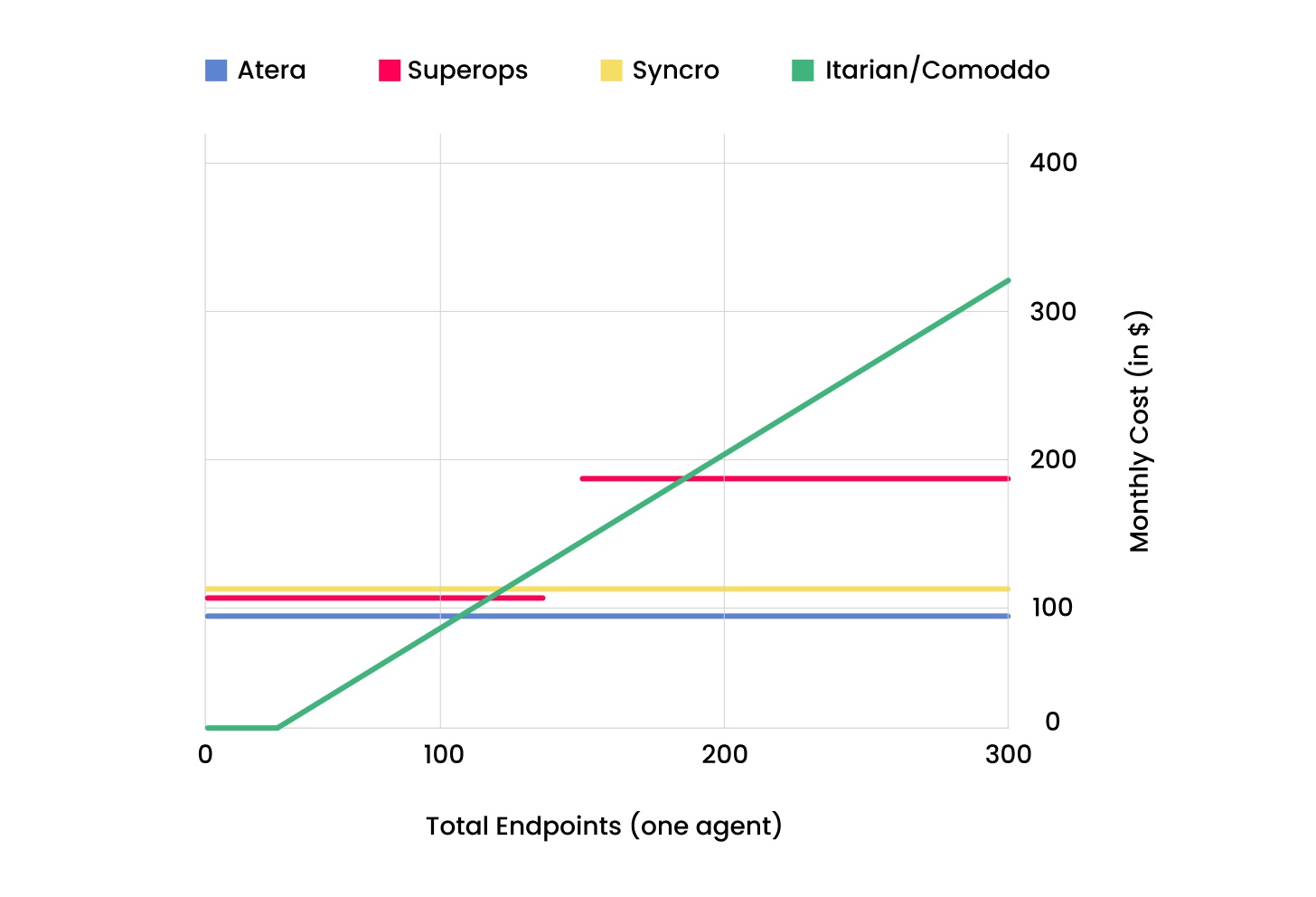
If all endpoints are managed by a single agent the pricing comparison will look like this, which is surely less than ideal.
Looking for an RMM software that fits your bill? |
So once we know which platform to use based on our budgeting and plans for expansion, we focus on the next criteria
2. Essential features
For this study, we considered endpoint monitoring, single console/dashboard to manage all services, remote access either inbuilt or integrated, and patch management/deployment as the most essential RMM features. Some near-essential features were issue management, alert management, ticketing, and automated network discovery.
All of our contenders did well on almost all of the aspects. In terms of Pure RMM functionality, ITArian, NinjaRMM, Atera, SuperOps, N-able, and Syncro are all feature-packed, with their own take on what’s more important for RMM users.
Kaseya also had a great set of features for all MSPs. Naverisk and ManageEngine Desktop Central were next.
One of the key things that all RMMs must do is integrate well with other MSP platforms and software like remote access or PSA technologies and all of our contenders did that well. While Atera, Syncro, SuperOps, Naverisk and Datto countered it by adding their own PSA, ITarian, Ninja RMM, Manage Engine Central, and N-able did that by being part of larger suites which gave a lot of functionality to the MSPs.
3. Battle of the user interface!
Here’s one criteria where we definitely beat others in. SuperOps wins this battle with its modern intuitive UI. Because of its human-centered design, everything in SuperOps looks and feels better. It’s easy to onboard and to start using.
N-able is the closest competition as the interface was simple to learn and genuinely fun to work on.
Atera also has a clear UI with customizable widgets but some users have complained about the interface lagging, nothing we could verify though. Syncro tries hard but the whole UI feels disconnected and you find things out of place at times, impacting your workflow. Datto has also updated its UI but some functions still required users to go into the old UI.
The rest of the pack works with functional dashboards. Some are stacked with tabs and buttons to access different functions. They work well but they can’t match us in the way that you will really enjoy working on our platform and how neatly everything flows.
Once we have our budget, needs, and UI choices, now we can look beyond the Must-Have features to also good-to-have.
We don't need to convince you here! SuperOps' UI rocks |
4. The extra bells and whistles
SuperOps has a closely-knit PSA solution. Intelligent automation can automate multiple repetitive tasks and empower agents to act only when their intervention is needed.
This also means you can have more devices under management with fewer agents.
Great integrations with other popular products make life easier for MSPs at multiple ends. It also has a lightweight CRM inbuilt.
Atera supports multiple operating systems including Windows, Mac, iOS, and Android. The ticketing tools are also very easy to use.
Syncro is another one with a PSA integration. It can monitor the network’s health and its best abilities lie in its robust remote access and billing abilities.
NinjaRMM is part of the NinjaOne suite and has a multi-tenanted architecture to keep the data of each MSP client separate. Apart from Windows, Mac, iOS, and Android devices, it can also manage Virtual machines. The ability to do security audits on entire managed IT systems is a plus. It has robust mobile apps for iOS and Android too.
N-able can detect issues in the network much better with their NetPath feature. It also scans the network for files with malware or threats continuously making it really secure.
ManageEngine Desktop Central allows you to set device profiles that can make onboarding new devices really easy with software and hardware configurations already set. It also keeps a software inventory which helps you detect outdated versions and update them on time.
ITarian’s auto-discovery feature makes its deployment the easiest. It has the best remote access functionalities which enable techs to access any file on any device connected to the network. Reporting functionality is good and has SLA and tech metrics that clients will appreciate.
Naverisk is appreciated for its really good project management and client management features and great integration with popular products. Its ability to run operations across the network with ease and scheduling are popular too.
Kaseya had a lot of great add-ons available but that’s exactly what it is - you have to add them on.
Across reviews, we read that Datto did make a lot of new features available but they didn’t deliver as expected.
5. Ease of use
You need easy-to-use software in day to day operations, to deploy and train personnel. Remember the Connectwise issue?
As creators and users of an RMM-PSA suite we didn’t feel it was fair for us to rate the apps ourselves, so we decided to use reviews across (G2 and Capterra) and used the average score to determine the ease of use winners - after all it's always the community that knows best.
Rank | RMM Platform | Avg score |
1 | NinjaRMM | 9.50 |
2 | SuperOps | 9.45 |
3 | Atera | 9.35 |
4 | Syncro | 9.35 |
5 | Itarian RMM | 8.95 |
6 | ManageEngine Desktop Central | 8.70 |
7 | Datto | 8.70 |
8 | Naverisk | 8.40 |
9 | N-able RMM | 8.30 |
10 | Kaseya | 8.1 |
6. Training and support
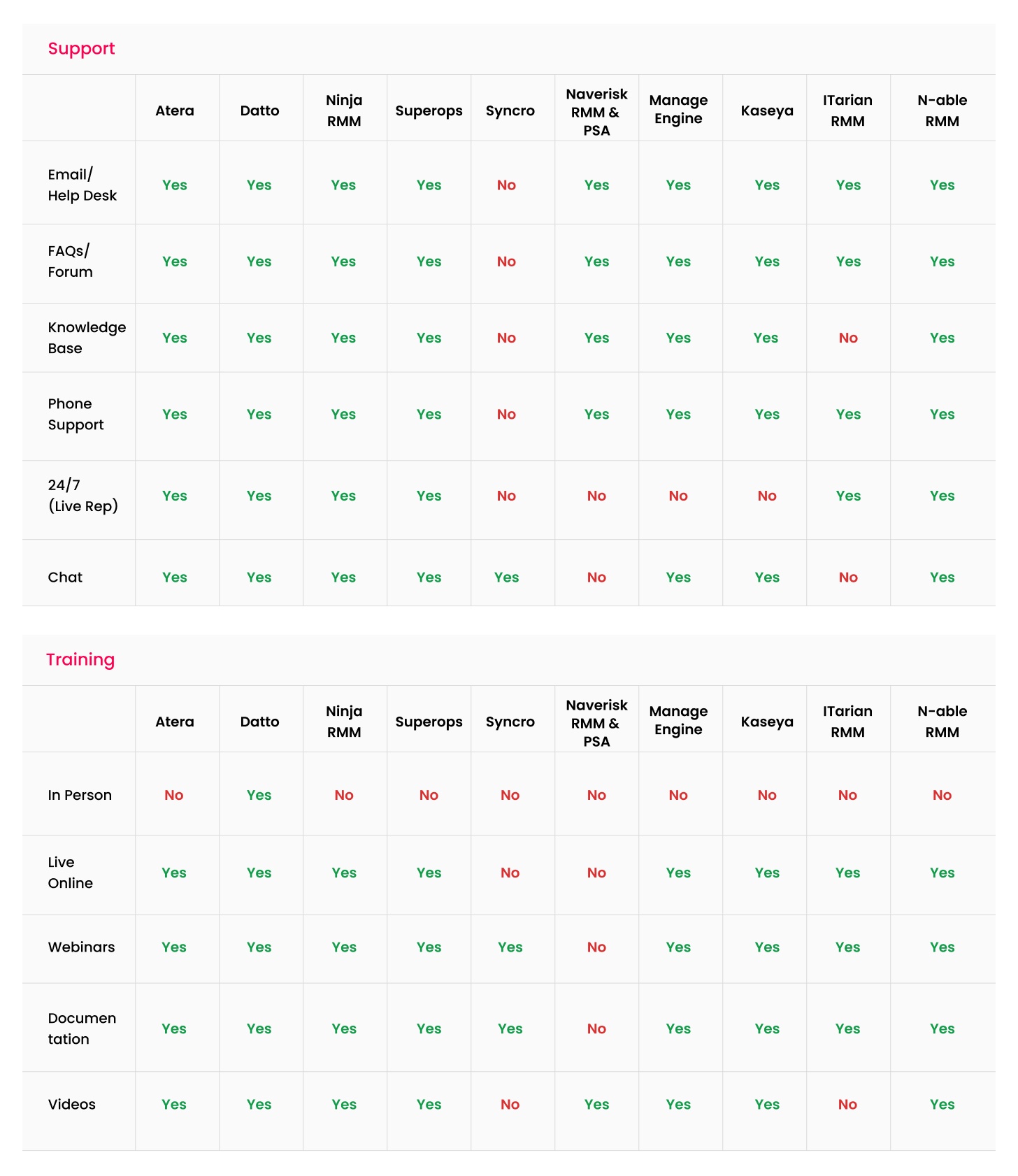
Source: Capterra
According to the user reviews, ITarian’s community is very strong and support delivery is great. NinjaRMM and ManageEngine are also appreciated for providing great support. Atera needs to work on its email support speed. N-able got mixed reviews for the support it provided. Syncro only provides chat support and user reviews suggest that they need to work on their response rate. Datto still offers in-person training.
At SuperOps, we pride ourselves on fast, helpful support, which reflects in the customer experience we create.
The best RMM solutions
So that’s about it, based on various considerations we think this is our list of best RMM solutions out there right now
N-Able RMM - N-able has a lot of great features
SuperOps - Intelligent automation with PSA, great UI, and competitive pricing
NinjaRMM - For feature-loaded RMM with good support, also NinjaOne suite.
Atera - Good in pricing and features
ITarian - Works for SMBs who have very few endpoints to manage
Syncro - If network health is your top priority and cost is not.
Manage Engine Desktop Central - If you use the ManageEngine Suite, this integrates well with Zoho services too
Naverisk - does its job well, but negotiate for a good quote though
Datto - Good UI but consistency issues persist
Kaseya - Old school interface, gets work done
We have not just given you our version of the top 10 but also shared with you our rationale and also each area where these software excel. You can now choose one of them as your first candidate for the trial.
Yes, trial. Because any service worth its salt will give you a chance to test it out before buying. This is because they know the value and the appeal of their product for user retention. It also gives you time to make sure that their features align with your MSP’s needs properly and that their quality exceeds your expectation. We believe in the same and that’s why we offer a 21-day trial without any commitment which you can try right here. For a limited time, you can get a flat 50% discount on your subscription across all our pricing plans.
We hope this guide helps you in identifying the right RMM software. Feel free to let us know about any big ones we missed or ones that you think to deserve to be here. Also, do leave us feedback on SuperOps - the platform, support, and more.
Have a kickass 2022.
Frequently asked questions
We have them answered.
All your favorite tools, right here
No hunting around for tickets, assets, projects, IT documentation - manage it all with SuperOps
